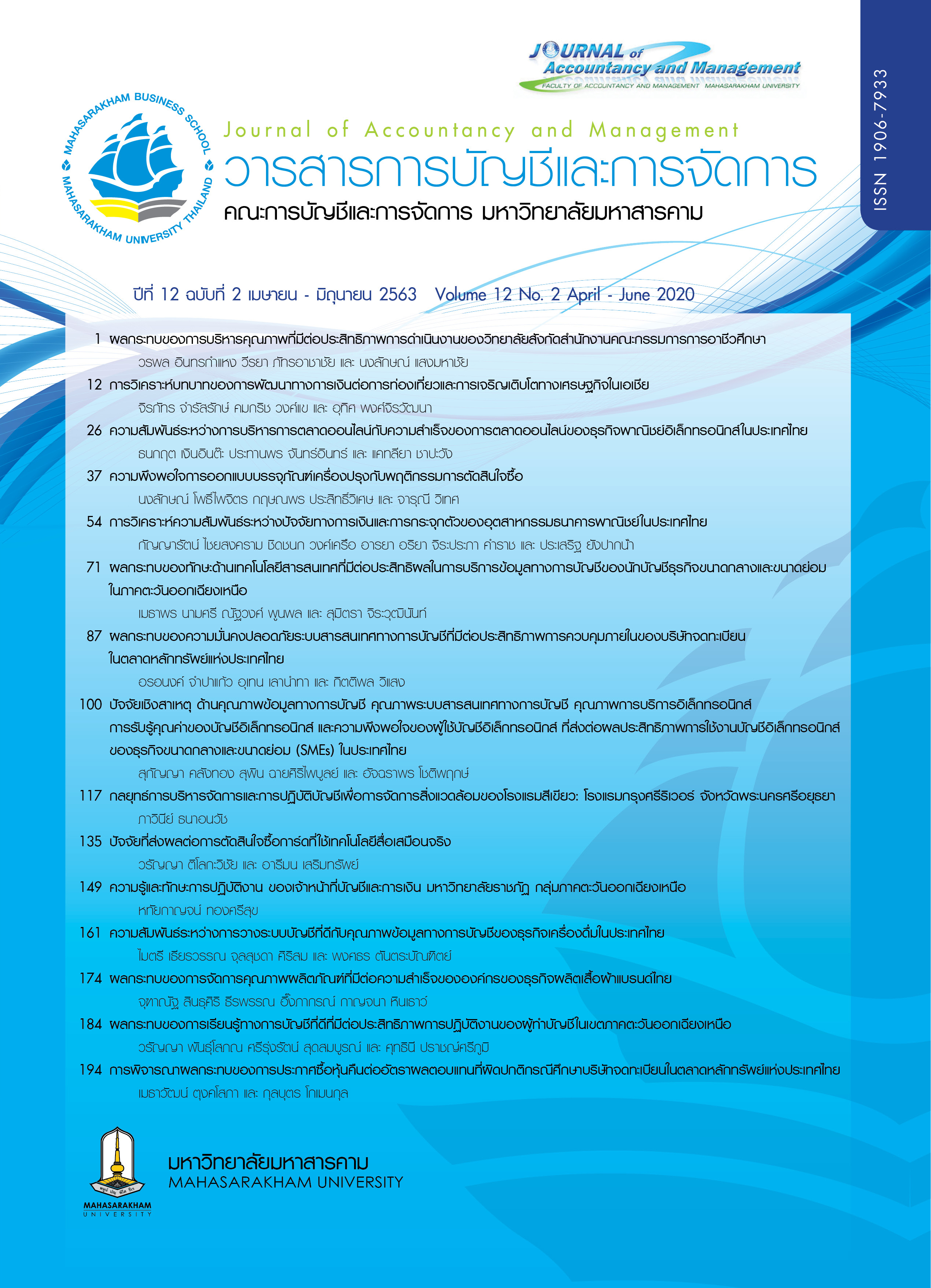ปัจจัยที่ส่งผลต่อการตัดสินใจซื้อการ์ดที่ใช้เทคโนโลยีสื่อเสมือนจริง
Main Article Content
บทคัดย่อ
การวิจัยครั้งนี้มีวัตถุประสงค์เพื่อศึกษาคุณภาพการบริการกับการซื้อการ์ดเทคโนโลยีสื่อเสมือนจริง หรือ เอ อาร์ การ์ด (Augmented Reality Card) ของผู้บริโภค โดยศึกษาถึงพฤติกรรมการซื้อการ์ดของผู้บริโภค ส่วนประสมทางการตลาด คุณภาพการบริการที่ส่งผลต่อการใช้การ์ดเทคโนโลยีสื่อเสมือนจริง และข้อมูลด้านประชากรศาสตร์ กลุ่มตัวอย่างที่ใช้ในงานวิจัยครั้งนี้ คือ ผู้บริโภคในเขตกรุงเทพมหานครและปริมณฑล โดยใช้ข้อคำถามเป็นเครื่องมือเพื่อเก็บรวบรวมข้อมูลจำนวนทั้งหมด จำนวน 406 คน วิเคราะห์ข้อมูลโดยใช้โปรแกรมสำเร็จรูปทางสถิติ ได้แก่ สถิติเชิงพรรณนา และสถิติเชิงอนุมาน ผลการศึกษาพบว่า กลุ่มตัวอย่างส่วนใหญ่เป็นเพศหญิง อยู่ในช่วงอายุ 30-39 ปี ระดับการศึกษาปริญญาตรี ประกอบอาชีพพนักงานเอกชน มีรายได้เฉลี่ย 15,001 – 30,000 บาทต่อเดือน มีพฤติกรรมการซื้อการ์ดผ่านทางหน้าร้านและออนไลน์ วัตถุประสงค์ในการสั่งซื้อเพื่อมอบให้เนื่องในโอกาสพิเศษ เช่น วันเกิด วันปีใหม่ วันวาเลนไทน์ และแสดงความยินดี ปัจจัยที่มีผลมากที่สุดในการตัดสินใจซื้อการ์ดคือ ด้านราคาของสินค้าและบริการ โดยส่วนใหญ่ให้ความสนใจกับการนำเทคโนโลยีเข้ามาเป็นส่วนหนึ่งของการ์ด และให้ราคาต่อการ์ดหนึ่งใบอยู่ที่ 100-200 บาท ปัญหาส่วนใหญ่ที่พบในการสั่งซื้อการ์ดคือ สินค้าไม่ตรงต่อความต้องการ ปัจจัยส่วนประสมทางการตลาด และปัจจัยคุณภาพการบริการ โดยรวมอยู่ในระดับมาก ผลจากการทดสอบสมมติฐาน พบว่า ปัจจัยส่วนประสมทางการตลาดมีความสัมพันธ์กับการซื้อเอ อาร์ การ์ด คือ ด้านผลิตภัณฑ์ ด้านราคา และด้านส่งเสริมทางการตลาด ที่นัยสำคัญทางสถิติที่ 0.05 ปัจจัยคุณภาพการบริการ มีความสัมพันธ์กับการซื้อเอ อาร์ การ์ด คือ ด้านความน่าเชื่อถือ ด้านการให้ความเชื่อมั่น ด้านความเป็นรูปธรรมของการให้บริการ ด้านการเอาใจใส่ และด้านการตอบสนอง ที่นัยสำคัญทางสถิติที่ 0.05.
Downloads
Article Details
บทความที่ได้รับการตีพิมพ์เป็นลิขสิทธิ์ของวารสารการบัญชีและการจัดการ
ข้อความที่ปรากฏในบทความแต่ละเรื่องในวารสารวิชาการเล่มนี้เป็นความคิดเห็นส่วนตัวของผู้เขียนแต่ละท่านไม่เกี่ยวข้องกับมหาวิทยาลัยมหาสารคาม และคณาจารย์ท่านอื่นๆในมหาวิทยาลัยฯ แต่อย่างใด ความรับผิดชอบองค์ประกอบทั้งหมดของบทความแต่ละเรื่องเป็นของผู้เขียนแต่ละท่าน หากมีความผิดพลาดใดๆ ผู้เขียนแต่ละท่านจะรับผิดชอบบทความของตนเองแต่ผู้เดียว
เอกสารอ้างอิง
กฤตินา จันทร์หวร. (2559). ปัจจัยที่มีอิทธิพลต่อการตัดสินใจซื้อสินค้ากิ๊ปช้อป ผ่านทางแอปพลิเคชันอินสตาแกรมของผู้บริโภคระดับชั้นมัธยมศึกษาในเขตกรุงเทพมหานคร. วิทยานิพนธ์มหาบัณฑิต. วิทยาลัยนวัตกรรมการจัดการ มหาวิทยาลัยเทคโนโลยีราชมงคลรัตนโกสินทร์.
กัลยา วานิชย์บัญชา. (2545). การใช้ SPSS for Windows ในการวิเคราะห์ข้อมูล. (พิมพ์ครั้งที่ 6). กรุงเทพมหานคร : ภาควิชาสถิติคณะพาณิชยศาสตร์และการบัญชีจุฬาลงกรณ์มหาวิทยาลัย.
กฤติยา ใหญ่โสมานัง. (2559). ปัจจัยที่มีผลต่อการตัดสินใจซื้อสินค้าและบริการผ่านระบบอินเทอร์เน็ตของพนักงานออฟฟิศในเขตกรุงเทพมหานคร. วิทยานิพนธ์มหาบัณฑิต. มหาวิทยาลัยนานาชาติแสตมฟอร์ด
ฉัตรเมือง เผ่ามานะเจริญ. (2559). การศึกษาวิเคราะห์พฤติกรรมผู้ใช้อินเทอร์เน็ตที่มีต่อการรวมกลุ่มมวลชนทางการตลาด. วารสารวิชาการนวัตกรรมสื่อสารสังคม, 4(2), 93-103.
ชนนาถ แสงเจริญ. (2558). โครงการจัดตั้งร้าน Scrap Form Heart. การค้นคว้าอิสระบริหารธุรกิจมหาบัณฑิต สาขาวิชาการจัดการสาระและการสร้างคุณค่า คณะการจัดการสาระและการสร้างคุณค่า.มหาวิทยาลัยกรุงเทพ.
ชัยอนันต์ สาขะจันทร์. (2559). การพัฒนาการเรียนแบบร่วมมือโดยการประยุกต์ใช้เทคโนโลยีความจริงเสริมเพื่อส่งเสริมทักษะปฏิบัติและความคงทนทางการเรียน สำหรับนักศึกษาหลักสูตรวิศวกรรมศาสตร์บัณฑิต วิทยานิพนธ์มหาบัณฑิต. มหาวิทยาลัยเทคโนโลยีราชมงคลรัตนโกสินทร์.
ณัฏฐา ผิวมา และปริศนา มัชฌิมา. (2559). การพัฒนาแอปพลิเคชันด้วยเทคโนโลยี ความเป็นจริงเสริมเพื่อส่งเสริมการเรียนรู้ ศิลปวัฒนธรรมภูมิปัญญาเรื่องการทำบาตรของชุมชนบ้านบาตร. วิทยานิพนธ์มหาบัณฑิต. มหาวิทยาลัยดุสิต.
ธีระ ศิริเจริญ. (2556). การพัฒนาอัลกอริทึมเพื่อส่งข้อมูลจุดที่สนใจ และการกำหนดขอบเขตการค้นหาสำหรับเทคโนโลยีเออาร์บนโทรศัพท์มือถือ. วิทยานิพนธ์มหาบัณฑิต. สถาบันเทคโนโลยีพระจอมเกล้าเจ้าคุณทหารลาดกระบัง.
บุษกร มโนตรัยรัตน์. (2559). ปัจจัยที่มีอิทธิพลต่อความตั้งใจซื้อผลิตภัณฑ์ Personalized gift ประเภทของใช้ผ่านทางออนไลน์. วิทยานิพนธ์มหาบัณฑิต. มหาวิทยาลัยธรรมศาสตร์.
หอการค้าไทย. (2561). การใช้จ่ายของผู้บริโภคช่วงเทศกาลปีใหม่.ค้นเมื่อ 24 สิงหาคม 2562, จาก http://cebf.utcc.ac.th/upload/poll_file/file_th_94d25y2017.pdf
ศิริวรรณ เสรีรัตน์. (2550). พฤติกรรมผู้บริโภค. กรุงเทพมหานคร : บริษัท ธีระฟิล์ม และไซเท็กจำกัด.
สมศักดิ์ เตชะโกสิต. (2559). รูปแบบการเรียนรู้จินตวิศวกรรมทางวิทยาศาสตร์ด้วยเทคโนโลยี ความเป็นจริงเสริมเพื่อการรู้สะเต็ม. วิทยานิพนธ์มหาบัณฑิต. มหาวิทยาลัยเทคโนโลยีพระจอมเกล้าพระนครเหนือ.
อำนาจ หังษา. (2560). สื่อประชาสัมพันธ์ความเป็นจริงเสริมเพื่อการท่องเที่ยวในจังหวัดพระนครศรีอยุธยา. วิทยานิพนธ์มหาบัณฑิต. มหาวิทยาลัยเทคโนโลยีราชมงคลธัญบุรี.
Aungst, S. G., & Wilson, D.T. (2005). A primer for navigating the shoals of applying wireless technology to marketing problems. The Journal of Business and Industrial Marketing. 20(2/3), 59-69.
Cronbach, L. J. (1990). Essentials of psychological testing. 5TH ed. New York : Harper Collins Publishers. 202-204.
Ivy, J. (2018). A new higher education marketing mix: the 7Ps for MBA marketing . International Journal of Education Management. 288-299.
Leymann, F., Fehling, C., Mietzner, R., Nowak, A. & Dustder, S. (2011). Moving application to the cloud: an approach based on application model enrichment. International Journal of Cooperative Information Systerns. 20(3), 307-356.
Parasuraman, A., Ziethaml & Berry, L.L. (1988). SERVQUAL: A Multiple- Item Scale for Measuring Consumer Perceptions of Service Quality. Journal of Retailing. 12-40.
Skog, D.A., Wimelius, H. & Sandberg, J. (2018). Digital Disruption Business & Information Systems Engineering 60. 431–437. https://doi.org/10.1007/s12599-018-0550-4.
Vaidya, Alpana & Pathak, Vinayak & Vaidya, Ajay. (2016). Mobile phone usage among youth. International Journal of Applied Research and Studies. 5. 10.20908/ijars.v5i3.9483.
Yamane, T. (1967). Statistic: An introductory analysis. 3rd Edition. Harper and Row,.New York.


